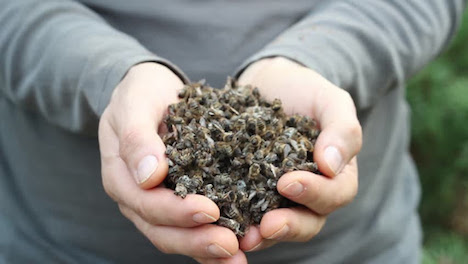DISAPPEARING BEES
BY: TAYLOR HOLT
It is spring time. Hunters
rave about gobbling turkeys, while April showers bring May flowers in full
bloom. How is it that those beautiful flowers that so many people love come to
be pollinated? Bees. Bees are stereotyped most times as “annoying flying
insects that serve no purpose in the world.” When in all reality, bees play a
major role in habitat management, food production, biodiversity and many other aspects
throughout the world. There are almost 4,000 species of bees in North America. Often
compared to other flying insects, bees are unique in the fact that they gather
pollen and nectar as a food source for their young.
*DID YOU KNOW? Wasps and
bees are closely related. They both collect nectar and pollen, but a wasp’s
young are carnivorous and require a food source of protein during early
development.*
 |
| (A)- Array of native bee species |
Bees are facing quite a
front that could lead to uncontrollable spiraling decline in populations. New
diseases, pesticide use, changes in agriculture and urbanization that decreases
flower covered landscapes are only some of the known causes of colonies
collapsing. Only until most recently, 2006-2007, beekeepers derived the term “Colony
Collapse Disorder” (CCD) to describe the phenomena of keepers reporting 30-90%
loss in aviary hives. Although, many keepers say issues of hive loss began long
before CCD; after World War II, agricultural farms became much larger and
introduced the use of commercial pesticides.
 |
| (B)- Spraying DDT, a pesticide used after WWII that is now banned |
Clint Otto, a United
States Geological Survey ecologist at the Northern Prairie Wildlife Research
Center in Bismarck, North Dakota, leads a study to understand habitat influence
on bee health and honey production. So far in his findings, he has found that
honeybees need to collect pollen from a variety of different plant species to
compile essential sets of nutrients for optimal colony health. Colonies
surrounded by undeveloped habitat produced higher quantity and higher quality
of honey versus colonies surrounded by agriculture and development. However,
loss of habitat and essential nutrition is not the sole solution to the
honeybees’ challenges.
Dead bees do not always
leave CCD as the culprit. Since pesticides became more popular after being more
widely introduced following World War II, it is not a shock that these
chemicals are harmful to not only humans but bees as well. Instructions and
labels have now been placed on pesticides to ensure safe use. Overexposure to a
pesticide can kill an entire hive, a mistake that could have been avoided by
reading the safety label. Overexposure to a pesticide is called acute pesticide
poisoning. Acute pesticide poisoning can be identified by large numbers of dead
bees outside the entrance of the hive. CCD results in a very minimal number of
dead bees found near the hive. Along with poisoning, disease is another theory
as to the decline of bees in recent years. New diseases and parasites, such as
varroa mite and Nosema gut parasites, are factors in researching the reasons
behind CCD.
In efforts to respond to
CCD and declining pollinator species, the United States Department of
Agriculture (USDA) gathered a group of professionals from a variety of different
agencies to collaborate on data and survey collection, testing of samples, research
into theoretical factors and preventative management strategies to improve the
health of the bees and their habitats.
 |
| (C)- Bees killed by acute pesticide poisoning. |
In conclusion, North
America’s over 4,000 species of bees are in decline from a variety of factors.
Colony Collapse Disorder was a term created to describe the 30-90% die-off’s
beekeepers were observing in their aviaries, but research showed that loss of optimal
habitat, food sources, use of pesticides leading to acute pesticide poisoning,
and new diseases and parasites are only a few of the factors involved in the
population numbers decline. Bees play a major role in not only small scale
aesthetics in my own personal garden that I grow vegetables and flowers in, but
on large scale agricultural farms that require pollination of the crops or
trees in order to produce their products.
 |
| (D)- Bees tending to a honeycomb |
Such a small insect can
play a such major role in the environment; that being said, what can you do to
do your part to impact the environment in a positive way? How will you leave
your mark? Their numbers may be declining, but try not to be out-competed by the
mighty bees.
LITERATURE CITED
National Geographic. 2016. The last, best refuge for North America's bees. <http://news.nationalgeographic.com/2016/06/the-last-best-place-in-north-america-to-keep-bees/>. Accessed 27 Apr 2017.
Proceedings of the National Academy of Sciences of the United States of America [PNAS]. Changes in the transcript abundance relating to colony collapse disorder in honey bees (Apis mellifera). <http://www.pnas.org/content/106/35/14790.abstract>. Accessed 26 Apr 2017.
The Wildlife Society [TWS]. 2017. Surveying native bee species. <http://wildlife.org/surveying-native-bee-species/>. Accessed 26 Apr 2017.
United States Environmental Protection Agency [EPA]. Pollinator protection- colony collapse disorder. <https://www.epa.gov/pollinator-protection/colony-collapse-disorder>. Accessed 26 Apr 2017.
PICTURES
A-<http://www.beecityusa.org/resources.html>
B-<https://www.chem.info/news/2015/06/decades-after-being-banned-ddt-still-potential-health-risk>
C-<http://axisoflogic.com/artman/publish/Article_75794.shtml>
D-<http://coloradobeekeepers.org/>
Hi Taylor, awesome blog post. I agree that bees play a major role in our environment and to us as well. I did not know that wasps and bees were closely related. I also didn't know that wasps young are carnivorous and require protein in their diet. Bees definitely have a tough life with all the threats they face. That is why its important that we support and help the bees in every way we can.
ReplyDeleteGreat topic Taylor! I think that bees are very important in our environment as they provide the necessary transmission of pollen for our plants and trees to reproduce. Without our help the bees could end up becoming extinct and drastically affect our environment, plus hurt our way of life. We should be looking into different ways to protect crops instead of pesticides as well as a way to cure the diseases that bees face that could in turn wipe out a species.
ReplyDelete